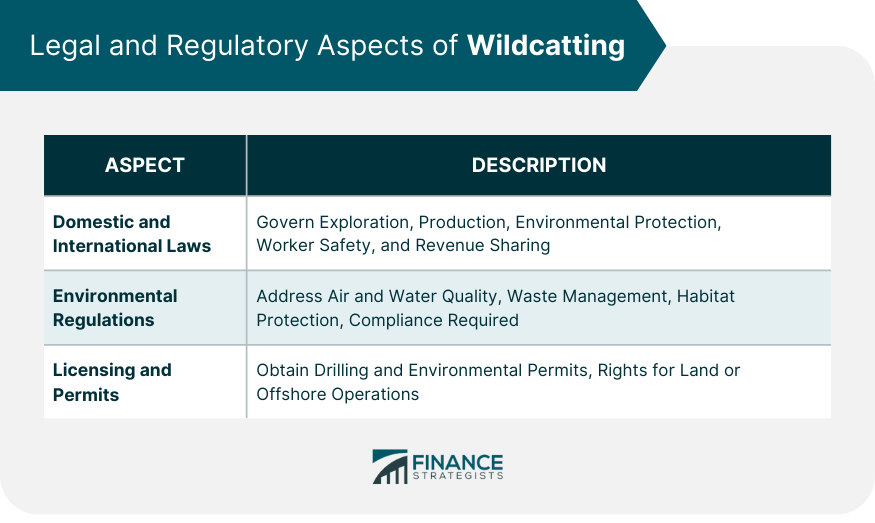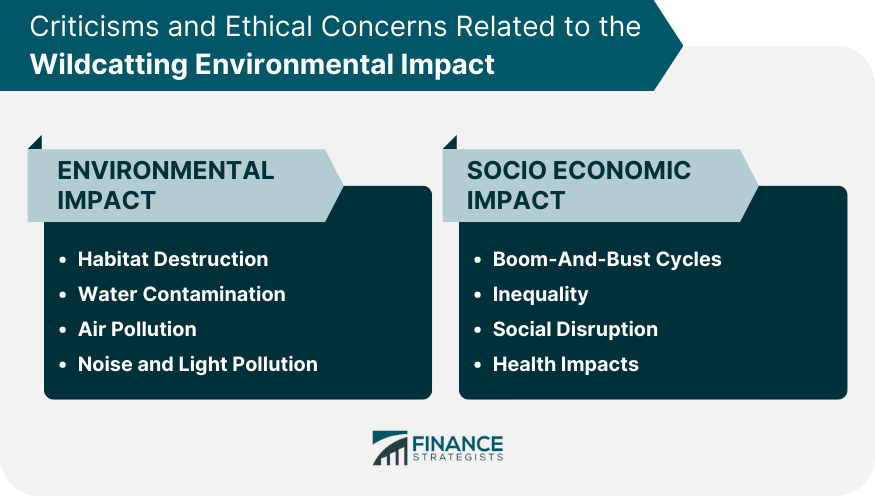Wildcatting, a term with a rich historical legacy, originates in the oil and gas industry. At its core, wildcatting refers to the process of drilling for oil or gas in unproven, unexplored areas, hoping for a significant discovery. The term is believed to have been derived from wildcatters, who would venture into 'wildcat territories,' areas unknown to contain oil or gas reserves. The history of wildcatting dates back to the early days of the oil industry in the 1850s. Pioneers in the sector would take on considerable risks, drilling in unknown areas with the hope of striking it big. This spirit of adventure and high-risk tolerance became the essence of wildcatting, a concept that has since been applied beyond the oil and gas industry to denote high-risk, potentially high-reward ventures. Wildcatting is synonymous with high-risk, high-reward ventures in oil and gas exploration. Wildcatters often face substantial financial risk, technical challenges, and regulatory hurdles. However, the potential rewards are enormous. A successful wildcat drilling operation can lead to the discovery of a substantial reserve, resulting in significant profits for the wildcatter and a boost to the local economy. The wildcatting process in oil and gas exploration involves several stages. First, a potential site is identified through geological surveys and seismic data analysis. Once a site is selected, drilling operations begin. If oil or gas is discovered, further tests are carried out to determine the reserve's size and viability. Finally, if the reserve is deemed commercially viable, production begins. Wildcatting has profoundly impacted the oil and gas industry despite its high-risk nature. Many of the world's largest oil and gas fields were discovered by wildcatters. Moreover, wildcatting has driven technological innovation in exploration and drilling techniques, contributing to the industry's growth and evolution. Investing in wildcatting operations is not for the faint-hearted. The risk of failure is high, as many wildcat wells turn out to be 'dusters' or non-productive wells. However, successful ventures can yield enormous returns, making wildcatting an attractive investment opportunity for those with a high-risk tolerance. Venture capital and private equity play a significant role in funding wildcatting operations. These investors are often drawn to the high-risk, high-reward nature of wildcatting, providing the necessary capital for exploration and drilling operations. In return, they stand to gain a substantial share of the profits if a significant oil or gas reserve is discovered. Given the high risk of wildcatting, insurance, and risk mitigation strategies are crucial. These may include diversifying investments across multiple drilling operations, insuring against specific risks such as drilling accidents, and employing advanced exploration technologies to increase the chances of success. Wildcatting operations are subject to a host of domestic and international laws. These laws govern various aspects of exploration and production, including environmental protection, worker safety, and revenue sharing. Non-compliance can result in hefty fines, legal action, and reputational damage. Environmental regulations play a significant role in wildcatting. These regulations aim to mitigate the environmental impact of drilling operations, protecting local ecosystems and communities from potential harm. Wildcatters must comply with various regulations, including those pertaining to air and water quality, waste management, and habitat protection. Before wildcatting operations can begin, a range of licenses and permits must be obtained. These may include drilling permits, environmental permits, and rights to access land or offshore areas. The process can be complex and time-consuming, requiring a deep understanding of the regulatory landscape. One of the most notable examples of successful wildcatting is the discovery of the Spindletop oilfield in Texas in 1901. This venture, which marked the birth of the modern petroleum industry, yielded a gusher that produced an unprecedented 100,000 barrels of oil daily. Another example is the discovery of the Ekofisk oil field in the North Sea in 1969 by Phillips Petroleum. This marked the start of offshore oil drilling in the North Sea, leading to a significant shift in the global energy landscape. Technological advancements have had a significant impact on wildcatting. Modern seismic imaging techniques and data analysis tools allow for more accurate predictions, reducing the risk of drilling a duster. Drilling technologies have also evolved, enabling operations in challenging environments such as deep water and arctic regions. Data analysis and predictive modeling play an increasingly important role in wildcatting. By analyzing historical data and employing predictive models, wildcatters can make more informed decisions, improving the chances of success and mitigating risk. The wildcatting concept has been applied in the mining industry, where explorers take on considerable risk in the hope of discovering mineral deposits. Just like in oil and gas, successful ventures can yield significant rewards. In the tech industry, wildcatting refers to the process of launching a startup with a novel, unproven business idea. Despite the high failure rate, successful tech startups can become industry disruptors, yielding massive returns for early investors. The environmental impact of wildcatting is a significant concern and often a point of criticism. These impacts include: Habitat Destruction: Drilling operations can cause significant disruption to local ecosystems. The construction of drilling sites and infrastructure often involves clearing large land areas, leading to habitat destruction and biodiversity loss. Water Contamination: The drilling process can contaminate local water sources. Drilling fluids and chemicals can seep into groundwater or spill into surface water, posing a risk to both human health and aquatic life. Air Pollution: Wildcatting operations can emit various pollutants into the atmosphere, including methane, a potent greenhouse gas. These emissions contribute to air pollution and climate change. Noise and Light Pollution: Drilling operations often involve loud machinery and bright lights, leading to noise and light pollution that can disrupt wildlife and local communities. Despite the existence of regulations and mitigation strategies, such as the use of more environmentally friendly drilling fluids and the restoration of habitats post-drilling, environmental damage is often inevitable, and restoration can take decades. Wildcatting also has several socioeconomic implications: Boom-And-Bust Cycles: Wildcatting can create boom-and-bust cycles in local economies. A successful discovery can lead to rapid economic growth, job creation, and increased public revenue. However, these benefits can be short-lived. Inequality: The wealth generated by wildcatting often does not benefit local communities evenly, leading to increased inequality. While some may reap the benefits, others may bear the costs, such as environmental degradation and social disruption. Social Disruption: The influx of workers and rapid economic changes associated with wildcatting can lead to social disruption. This can include increased cost of living, pressure on local services, and changes in community dynamics. Health Impacts: The environmental impacts of wildcatting can also lead to health issues in local communities, such as respiratory problems due to air pollution and health risks associated with contaminated water. The future of wildcatting is likely to be shaped by several trends. These include the transition to renewable energy, exploration and drilling technologies advances, and changing regulatory landscapes. As the world moves towards a low-carbon future, the oil and gas industry will need to adapt, potentially impacting the role of wildcatting. The transition to renewable energy poses both challenges and opportunities for wildcatting. While it could lead to a decline in oil and gas exploration, it could also spur wildcatting in new areas, such as geothermal energy and rare earth minerals, crucial for renewable energy technologies. Wildcatting, the high-risk, high-reward practice of exploring uncharted territories for oil or gas reserves, has shaped the energy industry for over a century. Other sectors have borrowed its concept to represent ventures seeking substantial returns despite significant risks. The practice underscores the necessity of risk tolerance, resilience, and adventurous spirit in business ventures. Moreover, it stresses the vital role of technology, research, and data analysis in risk mitigation and success likelihood. Compliance with regulatory frameworks and management of potential environmental impacts are also significant aspects of wildcatting. While investments in such ventures can yield substantial returns, they come with high risks. Therefore, it's crucial to incorporate them into a well-planned wealth management strategy, including portfolio diversification. Financial professionals can offer useful advice on how such ventures can complement your broader financial plan. Ultimately, thorough market research and clear understanding are key when embarking on the high-stakes journey of wildcatting.What Is Wildcatting?
Wildcatting Concept in Oil and Gas Exploration
High Risk, High Reward Nature
Stages in Exploration Process
Impact on the Oil and Gas Industry
Financial Implications of Wildcatting
Investment Risk and Potential Returns
Role of Venture Capital and Private Equity
Insurance and Risk Mitigation Strategies
Legal and Regulatory Aspects of Wildcatting
Domestic and International Laws
Environmental Regulations and Concerns
Licensing and Permits

Successful Ventures of Wildcatting
Technological Innovations Impacting Wildcatting
Advanced Exploration Technologies
Role of Data Analysis and Predictive Modeling
Wildcatting in Other Industries
Mining
Tech Startups
Criticisms and Ethical Concerns Related to Wildcatting
Environmental Impact
Socioeconomic Impact
Once the resource is depleted, or if the operations are unviable, the local economy can experience a sharp downturn.
Future of Wildcatting
Potential Trends and Predictions
Effect of Renewable Energy Transition
Final Thoughts
Wildcatting FAQs
The success rate of wildcatting varies greatly, but it is generally low. According to some estimates, only one in ten wildcat wells yields commercially viable reserves.
Technology plays a crucial role in modern wildcatting. Advanced exploration technologies, data analysis, and predictive modeling help reduce the risk of drilling a duster, while innovations in drilling technologies enable operations in challenging environments.
Wildcatting can have significant environmental impacts. These include habitat destruction, water contamination, and greenhouse gas emissions. Despite regulatory measures and mitigation efforts, some level of environmental impact is often inevitable.
The transition to renewable energy could lead to declining oil and gas wildcatting. However, it could also spur wildcatting in new areas, such as geothermal energy and rare earth minerals, which are crucial for renewable energy technologies.
Investors can mitigate the risks associated with wildcatting through a combination of diversification, insurance, and due diligence. Consulting with a financial advisor and understanding the regulatory landscape can also be beneficial.
True Tamplin is a published author, public speaker, CEO of UpDigital, and founder of Finance Strategists.
True is a Certified Educator in Personal Finance (CEPF®), author of The Handy Financial Ratios Guide, a member of the Society for Advancing Business Editing and Writing, contributes to his financial education site, Finance Strategists, and has spoken to various financial communities such as the CFA Institute, as well as university students like his Alma mater, Biola University, where he received a bachelor of science in business and data analytics.
To learn more about True, visit his personal website or view his author profiles on Amazon, Nasdaq and Forbes.















